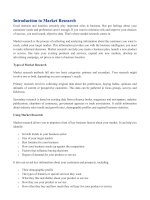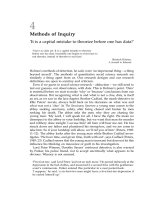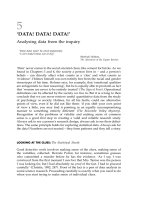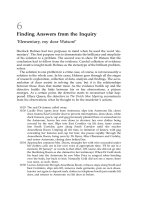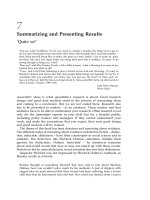Introduction to Market Research
Bạn đang xem bản rút gọn của tài liệu. Xem và tải ngay bản đầy đủ của tài liệu tại đây (157.21 KB, 23 trang )
Introduction to Market Research
Good instincts and intuition certainly play important roles in business. But gut feelings about your
customers' needs and preferences aren’t enough. If you want to minimize risk and improve your chances
of success, you need sound, objective data. That's where market research comes in.
Market research is the process of collecting and analyzing information about the customers you want to
reach, called your target market. This information provides you with the business intelligence you need to
make informed decisions. Market research can help you create a business plan, launch a new product or
service, fine tune your existing products and services, expand into new markets, develop an advertising
campaign, set prices or select a business location.
Types of Market Research
Market research methods fall into two basic categories: primary and secondary. Your research might
involve one or both, depending on your company’s needs.
Primary research involves collecting original data about the preferences, buying habits, opinions and
attitudes of current or prospective customers. This data can be gathered in focus groups, surveys and field
tests.
Secondary research is based on existing data from reference books, magazines and newspapers, industry
publications, chambers of commerce, government agencies or trade associations. It yields information
about industry sales trends and growth rates, demographic profiles and regional business statistics.
Using Market Research
Market research allows you to pinpoint a host of key business factors about your market. It can help you
identify:
o Growth trends in your business sector
o Size of your target market
o Best location for your business
o How your business stacks up against the competition
o Factors that influence buying decisions
o Degree of demand for your product or service
It also can reveal key information about your customers and prospects, including:
o Their demographic profile
o The types of features or special services they want
o What they like and dislike about your product or service
o How they use your product or service
o How often they buy and how much they will pay for your product or service
Once you analyze the results of your market research, you'll be in a better position to create a focused
business plan, develop a targeted advertising campaign, set competitive prices, select a new business
location or take other steps to grow your company.
Market-Research Techniques
Market research can provide critical information about the buying habits, needs, preferences and opinions
of current and prospective customers. While there are many ways to perform market research, most
businesses use one or more of five basic methods: surveys, focus groups, personal interviews, observation
and field trials. The type of data you need and how much money you?re willing to spend will determine
which techniques you choose for your business.
1. Surveys. Using concise, straightforward questionnaires, you can analyze a sample group that represents
your target market. The larger the sample, the more reliable the results.
o In-person surveys are one-on-one interviews typically conducted in high-traffic locations such as
shopping malls. They allow you to present people with samples of products, packaging or
advertising and gather immediate feedback. In-person surveys can generate response rates of more
than 90 percent, but they are costly. With the time and labor involved, the tab for an in-person
survey can run as high as $100 per interview.
o Telephone surveys are less expensive than in-person surveys, but costlier than mail. However, due
to consumer resistance to relentless telemarketing, getting people to participate in phone surveys
has grown increasingly difficult. Telephone surveys generally yield response rates of 50 percent to
60 percent.
o Mail surveys are a relatively inexpensive way to reach a broad audience. They're much cheaper
than in-person and phone surveys, but they only generate response rates of 3 percent to 15 percent.
Despite the low return, mail surveys are still a cost-effective choice for small businesses.
o Online surveys usually generate unpredictable response rates and unreliable data because you have
no control over the pool of respondents. But an online survey is a simple, inexpensive way to
collect anecdotal evidence and gather customer opinions and preferences.
2. Focus groups. In focus groups, a moderator uses a scripted series of questions or topics to lead a
discussion among a group of people. These sessions take place at neutral locations, usually at facilities
with videotaping equipment and an observation room with one-way mirrors. A focus group usually lasts
for one to two hours, and it takes at least three groups to get balanced results.
3. Personal interviews. Like focus groups, personal interviews include unstructured, open-ended
questions. They usually last for about an hour and are typically recorded.
Focus groups and personal interviews provide more subjective data than surveys do. The results are not
statistically reliable, which means they usually don't represent a large segment of the population.
Nevertheless, focus groups and interviews yield valuable insights into customer attitudes and are excellent
ways to uncover issues related to new products or service development.
4. Observation. Individual responses to surveys and focus groups are sometimes at odds with people's
actual behavior. When you observe consumers in action by videotaping them in stores, at work or at home,
you can observe how they buy or use a product. This gives you a more accurate picture of customers'
usage habits and shopping patterns.
5. Field trials. Placing a new product in selected stores to test customer response under real-life selling
conditions can help you make product modifications, adjust prices or improve packaging. Small business
owners should try to establish rapport with local store owners and Web sites that can help them test their
products.
Secrets of Successful Market-Research Studies
Whether your goal is to expand into new markets, introduce a new product or service, or gauge customer
reactions, even the smallest of small businesses can benefit from a simple but well planned market-
research study.
Market research helps you understand your market, your customers, your competitors and larger industry
trends. Good research will reveal details about your current customers and help you target new customers.
For example, before you open an organic produce market, find out if there's a demand for food grown
without pesticides and if customers will pay more for it.
In addition to giving you insight into customer needs, market-research studies can help you avoid costly
mistakes, such as introducing an unpopular new line of goods or developing a service that no one really
wants. Coca-Cola's introduction of New Coke in the 1980s shows what happens when decisions aren't
supported by good research. Coca-Cola revised the formula of its traditional Coke brand of soft drink and
lost millions in sales. By performing a study and asking people what they thought of the new formula, the
company could have avoided public-relations headaches.
When you set up a market-research study for your business, follow these basic guidelines:
Use the right sample. The research sample — your study’s group of participants — has to be just the
right size. Too large a sample costs too much, and too small a sample offers inaccurate results.
You also need to make sure you have the right samples from your overall population. Even a sample as
small as 1 percent of a market or group will work, as long as the sample truly reflects the overall
geographic area or population you want to query.
Mirror the market. Your surveys must reflect all characteristics of the market, such as geographical area
or population group from which it is drawn. Nielsen TV ratings are based on very small samplings of the
overall audience, but they're accurate to a few percentage points.
For example, if half of your target market is aged 65 and older and half is 30 and younger, make sure that
the sample size accurately reflects your demographic. If one-third of your market lives in one town and
two-thirds lives in another, your survey must reflect the geographic split in order to give you accurate
information about your market.
Get quantifiable results. Successful studies follow proven approaches, often based on the world of
statistics and sampling. But don’t worry — you don't need a PhD in mathematics. Most results can be
tabulated with simple arithmetic and broken down into percentages that anyone can understand.
If you follow these guidelines, you’ll collect information that can contribute to the success of your
enterprise. In short, market-research studies can save money, save time and — above all — save you from
disaster.
Market
Understanding Your Target Market
No business can be all things to all people. Instead, you must reach specific customers and satisfy their
particular needs. As an entrepreneur, you must identify those customers and understand as precisely as
possible what they want.
The process of finding and studying potential customers for your venture doesn´t have to be complex or
expensive -- but it is extremely important. In a nutshell, it requires you to find out everything you can
about the customers you intend to pursue. Once you have that information, you´ll have a much better
chance of capturing those customers for your business.
The facts you need to know about your target market fall into these three categories:
Demographics. Begin your research by checking the demographics of the region you plan to target. You
´ll want to know the population´s make-up in terms of age, gender, income level, occupation, education
and family circumstances (married, single, retired and so on).
To find that information, you´ll probably need to visit the local library. Good sources available at most
libraries include:
o Country and City Data Book, published by the U.S. Department of Commerce
o Survey of Buying Power Data Service, published by Sales and Marketing Management
Geographic and lifestyle factors. Give some thought to where and how your target customers live. Are
they Southerners or Yankees; urbanites, suburban soccer moms or country folk? Are they risk-takers or
conservative; athletes or couch potatoes; spenders or savers? The answers will help determine what you
can sell to them, how you should sell it and at what price.
Customer needs. Consider all the reasons why people might buy your product or service. For example,
say you´re opening a string of health clubs. Will your customers come to meet other people, to take
exercise classes or to play racquet sports with their friends? Find out by talking to people in the local
fitness industry and by quizzing friends or acquaintances who go to health clubs. Then you can design and
market your club accordingly.
Once you´ve considered the key demographic factors, you can begin to assemble a customer profile, a
more focused statement that describes your target market in detail. Consult that profile when you make
decisions about issues such as what products and services to offer or advertise; how much to charge for
various products; and expansion plans.
Market Survey
1. In what type of business, industry or profession do you work? (Please check one.)
Agriculture/forestry/construction
Data processing/computers
Finance/banking/insurance
Health care (medical, dental, etc.)
Real estate
Wholesale trade
Retail trade
Other: ______________ (please specify)
Communications/publishing/advertising
Education
Government/public administration
Manufacturing
Personal/business services (consultant,
CPA, lawyer, etc.)
Transportation/public utilities
2. What is your position? (Please check only one.)
Chairman of the Board
Owner/Partner
Other Company Officer (V.P., Treasurer,
etc.)
Manager
Scientist or Engineer
Sales
Clerical
Other: _______________ (please specify)
President/CEO
Director
Department Head
Supervisor/Foreman
Other administrative position not
mentioned
Technical Specialist
Retired
3. How many people, including yourself, work at your company, including branches, international
offices and plants? (Please check only one.)
Under 10
25 - 49
75 - 99
250 - 499
1,000 - 4,999
10,000 or more
10 - 24
50 - 74
100 - 249
500 - 999
5,000 - 9,999
4a. What are your company’s annual gross sales or revenues? (Include all plants, branches, divisions
and subsidiaries.)
Less than $250,000
$500,000 - $999,999
$5 million - $9.9 million
$25 million - $99.9 million
$250,000 - $499,999
$1 million - 4.9 million
$10 million - $24.9 million
$100 million or over
4b. What year did your business start? _______________
5. Do you serve on your company's board of directors?
Yes No
6. Are you on the board of directors of any other company?
Yes No
7a. Are you an owner or a partner of a business?
Yes No
7b. If you answered yes, in what industry or profession were you employed and what was your job title
before you became an owner or partner?
Industry or Profession: _______________________ Job Title:________________________
7c. Are you considering starting or buying a new or additional business?
Yes No
7d. If you are planning to start or buy a new business, when do you plan to do so?
In the next six months
In 13 to 24 months
Not sure
In 7 to 12 months
More than 24 months from now
8. In the last 12 months, have you been directly involved in initiating, recommending, ordering or
approving the purchase of any of the following products or services for your firm? (Please check all
that apply.)
Accounting services
Answering/paging systems
Building materials/equipment
Computers and computer accessories and/
or related computer equipment (include
time-sharing)
Credit cards
Fax machines
Insurance
Office supplies (including office paper)
Real estate and/or office or plant location
Telecommunications equipment/services
Travel services
Advertising /PR/sales promotion
Banking and financial services
Car/truck/van purchase or lease
Computer software
Copiers
Express mail/courier/package delivery,
overnight delivery
Office furniture and fixtures
Other office machines (calculators,
typewriters, postage meters, etc.)
Temporary office help/employee
recruitment
None of these
9. Which express mail/package delivery services do you use? (Please check all that apply.)
Federal Express
United Parcel Service
Emery/Purolator
U.S. Postal Service/Express Mail
DHL
Other: ______________ (please specify)
Motivation Survey
1. How knowledgeable are you about computers?
Very
Slightly
Somewhat
Not at all
2. Which of the following are important to you when evaluating a computer equipment purchase?
Check all that apply.
After-sales support
Best price for features
Easy to use
Lowest price available
Newest technology available
Reputation of vendor
Warranty
Attractive product
Brand name
Hardware compatibility
Most features/functions
Product quality
Compact size
Other: ______________ (please specify)
3. Which of the following sources of information do you use to make decisions about computer or
software purchases? (Please check all that apply.)
Business publications
Colleagues
In-store displays
PC Publications
Radio
Trade shows
Other: ______________ (please specify)
Catalogs
Consultants
Manufacturer's reps
Personal experience/knowledge
Television
Newspaper
4. Which of the following publications do you rely on for information regarding your business or your
plans to start a business? (Please check all that apply.)
Business Nation
Business Week
Byte
Computer Shopper
Computerworld
Entrepreneur
eWeek
Forbes
Fortune
Home Office Computing
Inc.
Independent Business
MacCentral
Macworld Online
PC Magazine
PC Novice
PC World
None of these
5. As a small-business owner, please check those of the following topics covered in Entrepreneur
magazine that you consider useful.
Tax information Financial (raising money, etc.)
